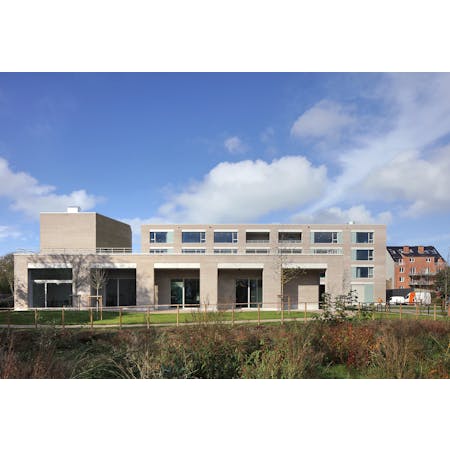
Woonzorgcentrum De Drie Platanen
A singular wave has suddenly appeared in the street front of Nieuwpoortsesteenweg on the outskirts of Ostend. The façade recedes from the straight line of the road in a flowing curve at precisely the point where the continuous urban buildings begin to give way to detached houses. On the ground floor, the surface of the façade is open and a courtyard can be glimpsed. On the other side, a tunnel provides an initial perspective of the landscape beyond. The playful line of the street façade turns out to be Bovenbouw Architectuur’s invitation to enter the residential care home they have designed and to follow a pathway straight through the building to the landscape at the back, which is normally screened off by the houses along this main road.
The courtyard is very clearly a public space, with all the necessary greenery and clad with mosaics by Leon Vranken. However, it is also a forecourt for the home: the entrance to the residential care centre only appears in the second line of the building, on the right-hand side. On the left, walkers can look into the busy kitchen, which in most similar institutions is regrettably all too often banished to the basement. The consultation rooms for various care-providers also look out onto the courtyard. Although the form of the building is initially reminiscent of a monastery, it soon becomes clear that it is an urban space tailor-made for the care home.
Beyond the courtyard, the path leads on, with no visible end, towards the landscape. This courtyard is the starting point for the ‘Green Ribbon’, the result of a large-scale operation to link together several green areas on the outskirts of the city. This is why the stream that forms the boundary between the properties of the care home and the local authority has been bridged. On the other side of the stream are the three plane trees that give the project its name, adjacent to which are allotments that change with the seasons and where local residents with green fingers animate the scene. Beyond this stretches the polder landscape, with the Green Ribbon pathway providing a visual axis.
These various layers of greenery provide the home with its view. On the one hand, as seen from the spacious communal areas on the upper floors, on the other from the secondary volume, a sort of oversized rear extension that stretches out towards the landscape and which contains a restaurant and a function room, among other things. The spaces here are arranged around a patio that exudes restfulness, something that is deliberately different to the larger courtyard. The lines of the walkway around the patio are purposely interrupted to break the perspective, as are the corridors between the rooms on the upper floors. In other places, the corridors run directly alongside the courtyard. At the front, the corridor follows the flowing line of the façade, which results in a variety of views of the street, which from some spots have the sea in the background. The curve creates space for a lookout post on each floor, an intimate room from which the residents can survey their surroundings at leisure. The range of impressions available in the encircling corridor is expanded even more by the varied use of materials, textures and colours. As in its architecture and urban planning siting, the interior of De Drie Platanen is an exercise in city living on the scale of a residential care home. It is an invitation to walk through the surroundings and to feel at one with them.
- Petrus Kemme
This project is published in Flanders Architectural Review N°14. When Attitudes Take Form








